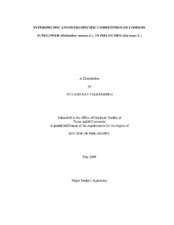| dc.description.abstract | Common sunflower is a competitive annual native dicot found in disturbed areas, on roadsides, dry prairies, and in row crops. Common sunflower is a competitive weed, but little data exist on interference, economic impacts, and competition in field corn. Field studies were conducted in 2006 and 2007 to 1) define the density-dependent effects of common sunflower competition with corn; 2) define the necessary weed-free periods of common sunflower in corn; 3) evaluate common sunflower control with herbicides; 4) and define the economic impact of common sunflower interference with corn.
Corn grain yield was significantly reduced when common sunflower densities reached 1 plant/m of row and potentitially damaging common sunflower densities occurred if allowed to compete for more than 2 to 4 wk after planting for maximum corn yield. No significant corn yield reduction occurred if common sunflowers emerged 8 wk after planting. Growing degree day (GDD) heat units for corn showed that the critical point for control of common sunflower was approximately 300 GDD. Atrazine applied PRE, atrazine followed by (fb) glyphosate or halosulfuron POST, glyphosate POST, halosulfuron POST, and halosulfuron plus nicosulfuron POST controlled >87% of common sunflower. Atrazine applied PRE in a 30-cm band, nicosulfuron POST, and atrazine broadcast plus S-metolachlor PRE showed significantly lower common sunflower control and corn grain yield, when compared to atrazine PRE fb glyphosate POST.
Economic impact of one sunflower/6 m of crop row caused a yield loss of 293 kg/ha. Various corn planting densities showed that corn yield can be reduced 1990 kg/ha with common sunflower competition. Corn planting densities of 49400 and 59300 plants/ha provided the greatest net returns with or without the presence of common sunflower competition. The highest net returns occurred with no common sunflower competition in 2006 and 2007, at $3,046/ha and $2,687/ha, respectively, when net corn prices were $0.24/kg ($6.00/bu). Potential control costs of various herbicide treatments revealed net returns of $1,156 to $1,910/ha in 2006 and $1,158 to $1,943/ha in 2007. Determining the economic impact of common sunflower interference in field corn allows producers to estimate the overall net return based upon density and duration of common sunflower interference, while considering varying net corn prices, crop planting density, and herbicide application costs. | en |


